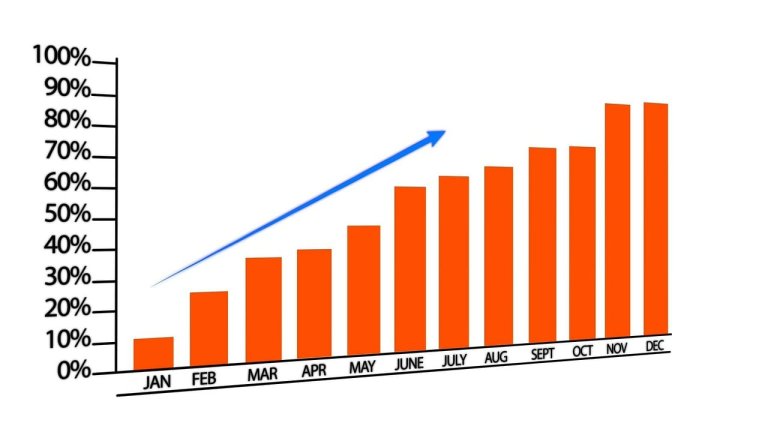Highcharts: How to Visualize Data on the Web
Is there an intuitive way to visualize data in your digital experiences? There sure is! Let us explore it here.
Written by Morten Eriksen on

Is there an intuitive way to visualize data in your digital experiences? There sure is! Let us explore it here.
Written by Morten Eriksen on
Data can tell compelling stories, but only if presented in an engaging and accessible way. Working with content, you may often grapple with the challenge of making complex information accessible to your audience.
Highcharts offers a solution by transforming raw data into interactive visualizations that captivate users and enhance their experience on your website. Instead of overwhelming visitors with numbers and statistics, you can present insights through dynamic charts and graphs that are both informative and visually appealing.
Engaging your audience in the digital age requires more than just compelling text; it demands interactive content that captivates users’ attention. Interactive charts and graphs draw users in, encouraging them to explore data in ways that static images or plain text cannot.
By allowing users to interact with data, you provide a more engaging and immersive experience that can lead to increased time spent on your site and a deeper understanding of your content.
Enhancing user experience through visual data representation is crucial for retaining visitors and conveying information effectively. Visual elements break up text-heavy pages, making your content more appealing and easier to understand.
They help convey complex information quickly, enabling users to grasp key insights at a glance. This not only improves comprehension but also keeps visitors engaged, reducing bounce rates and fostering a more meaningful connection with your audience.

So, what is Highcharts? Highcharts is a leading charting library that enables you to add interactive charts to your web pages effortlessly. It’s widely used across various industries, from finance to healthcare, due to its versatility and ease of use. With Highcharts, you can transform raw data into engaging visual stories that connect with your audience, all without requiring extensive technical expertise.
Highcharts seamlessly works with any back-end database or server stack, accepting data in various forms—including CSV, JSON, or live data streams. Deep customization is achievable through a simple options structure, allowing you to style your charts using JavaScript or CSS to fit your website’s design perfectly.
With integrations available for .NET, R, iOS, Android, and popular frameworks like Angular, Vue, and React, Highcharts is versatile enough to suit diverse development environments. Additionally, it enables you to export your charts to formats like PNG, JPG, PDF, or SVG, making it easy to share and publish your visualizations wherever needed.
Highcharts stands out as a powerful tool for web data visualization, offering several compelling reasons to integrate it into your website.
Highcharts is designed to be platform-agnostic, making it easy for your developers to incorporate it into various front-end frameworks and content management systems (CMS).
The integration process is straightforward for developers. The Highcharts product collection is based on Javascript and SVG that makes it a breeze for developers to create responsive, interactive and accessible data visualizations.
One of Highcharts’ strengths is its wide range of chart options. Whether you need line charts to show trends over time, bar charts for comparisons, pie charts for proportions, or scatter plots for distributions, Highcharts has you covered. Additionally, the charts are highly customizable, allowing you to adjust colors, fonts, and layouts to fit your website’s design and branding seamlessly.
In an era where users access content on various devices, Highcharts ensures that your charts adjust seamlessly to different screen sizes. The charts are responsive by default, looking great on desktops, tablets, and mobile devices. Interactive elements like tooltips, zooming, and clickable legends enhance user engagement, encouraging visitors to interact with your data and spend more time on your site.
Integrating Highcharts into your website is a fully manageable process for your developers. JavaScript is one of the fundamental languages of the web, something all developers can easily teach themselves.
When the developers have implemented the necessary code or ready-made integrations, you can choose the chart type that best represents your data. Prepare your data in a format that Highcharts can interpret, such as JSON or CSV.
You can then integrate Highcharts into your CMS by using a plugin or manually inserting the Highcharts code. Customize the chart’s appearance to align with your site’s branding, and once you’re satisfied, embed the chart on your webpage and publish it.
Highcharts offers comprehensive documentation to guide you through every step of the process. If you encounter any challenges, a supportive community and forums are available where you can get tips and solutions from other users who have experience with Highcharts.
Creating effective data visualizations involves more than just inserting a chart; it requires thoughtful planning and design.
Choosing the appropriate chart type is crucial. Match your data with the chart that best represents it—use line charts for trends over time, bar charts for comparisons among categories, and pie charts for illustrating proportions. The right chart type makes your data more understandable and impactful.
Keeping your visuals clean and focused enhances readability. Avoid clutter by highlighting only the most important data points and using whitespace effectively. Use colors and labels thoughtfully to improve clarity, ensuring that your charts are both aesthetically pleasing and easy to interpret.
Ensuring that your charts are accessible to all users is essential. Use high-contrast colors for better visibility and include alternative text descriptions for screen readers. This makes your data accessible to users with visual impairments and aligns with best practices for inclusive design.
***
Ready to bring your data to life? Explore Highcharts and start transforming your web content today. Visit the official Highcharts website for more resources and begin making your data visually compelling.
Get some more insights: